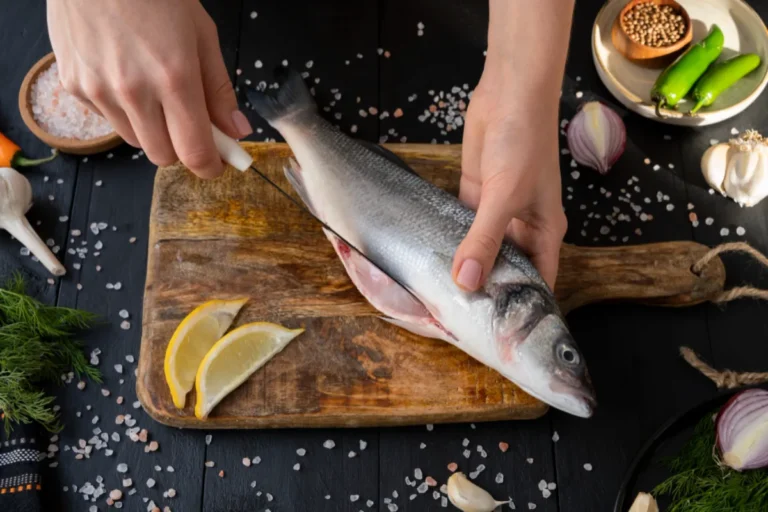When it comes to cooking fish, butter is a classic choice that has been used by chefs for centuries. But is butter really the best option for cooking fish? In this article, we will explore the benefits and drawbacks of using butter to cook fish, including how it affects flavor, texture, and nutrition. We’ll also delve into different cooking techniques that utilize butter, offer some popular recipes, and answer common questions about this delicious combination.
The Role of Butter in Cooking Fish
Butter is known for its rich flavor and creamy texture, making it a popular choice for cooking fish. It adds a depth of flavor that can complement the delicate taste of fish, and it also helps achieve a beautiful golden crust when used in techniques like sautéing and pan-frying. Butter has a relatively low smoke point compared to other cooking fats, so it’s best used at moderate temperatures to prevent burning.
For those interested in exploring the versatility of butter in fish dishes, this guide on how to make the perfect lemon butter sauce for fish is a great resource.
Why Butter Works Well with Fish
Butter enhances the natural flavors of fish while adding a rich, nutty taste. It also has the ability to carry other flavors, such as herbs, garlic, and lemon, making it a versatile ingredient in fish cooking. However, because butter has a low smoke point, it’s important to use it carefully to avoid burning. This is why techniques like poaching and baking, which involve lower temperatures, are particularly well-suited for cooking fish in butter.
To understand more about the best practices for using butter in cooking, you might find this article on pan-searing fish in butter helpful.
The Chemistry of Butter: Why It’s Ideal for Fish
Butter is composed of fat, water, and milk solids. The fat content is what gives butter its rich flavor and mouthfeel, while the water and milk solids contribute to browning and flavor development when cooking. However, the presence of milk solids also means that butter can burn if cooked at too high a temperature, which is why it’s often combined with other fats like olive oil for high-heat cooking.
Creating the Perfect Butter-Based Cooking Techniques
- Sautéing and Pan-Frying: When sautéing or pan-frying fish in butter, the key is to keep the heat moderate. This allows the butter to brown gently, creating a nutty flavor that complements the fish without burning the butter. Fish like tilapia, trout, and cod are excellent choices for these methods.
- Butter Poaching: Butter poaching is a luxurious method where fish is gently cooked in warm, emulsified butter. This technique results in a moist, tender texture and infuses the fish with a rich, buttery flavor. Butter poaching is particularly well-suited for delicate fish like halibut and lobster.
For a deeper dive into butter poaching, this butter-poached fish guide provides step-by-step instructions and tips.
Health Considerations: Butter vs. Other Cooking Oils
Butter is undeniably delicious, but how does it stack up against other cooking fats from a health perspective? While butter is rich in saturated fats, which should be consumed in moderation, it also contains important fat-soluble vitamins like A, D, and E. However, when compared to oils like olive oil, butter has a lower proportion of healthy unsaturated fats.
To make butter-cooked fish healthier, consider using a combination of butter and olive oil. This approach allows you to enjoy the rich flavor of butter while benefiting from the heart-healthy properties of olive oil.
Popular Recipes for Cooking Fish with Butter
There are countless ways to cook fish with butter, each offering a unique flavor profile and texture. Below are some popular recipes that highlight the versatility of butter in fish dishes.
Herb-Butter Sautéed Fish
- Ingredients:
- 2 fish fillets (such as tilapia or trout)
- 2 tablespoons unsalted butter
- 1 clove garlic, minced
- Fresh herbs (such as parsley or dill)
- Salt and pepper to taste
- Instructions:
- Melt the butter in a large skillet over medium heat.
- Add the garlic and sauté until fragrant.
- Season the fish with salt and pepper, then add to the skillet.
- Cook for 3-4 minutes on each side, until the fish is golden and cooked through.
- Sprinkle with fresh herbs and serve immediately.
This simple recipe pairs beautifully with a super crunch salad, adding a refreshing contrast to the rich flavors of the butter.
Garlic Butter Baked Fish
- Ingredients:
- 2 fish fillets (such as cod or halibut)
- 3 tablespoons unsalted butter, melted
- 2 cloves garlic, minced
- Juice of 1 lemon
- Fresh parsley, chopped
- Salt and pepper to taste
- Instructions:
- Preheat the oven to 375°F (190°C).
- In a small bowl, combine the melted butter, garlic, and lemon juice.
- Place the fish fillets in a baking dish and pour the butter mixture over them.
- Season with salt and pepper, then bake for 15-20 minutes, until the fish is flaky and cooked through.
- Garnish with fresh parsley before serving.
For those who enjoy a touch of sweetness with their savory dishes, consider serving this with a side of honey-butter skillet corn.
Lemon Butter Poached Salmon
- Ingredients:
- 2 salmon fillets
- 1 cup unsalted butter
- 1 lemon, sliced
- Fresh dill for garnish
- Salt and pepper to taste
- Instructions:
- In a saucepan, melt the butter over low heat, then add the lemon slices.
- Season the salmon with salt and pepper, then gently lower into the butter.
- Poach the salmon for 10-12 minutes, until just cooked through.
- Garnish with fresh dill and serve immediately.
For more poaching ideas, this collection of fish recipes offers a variety of techniques and flavor profiles to explore.
Nutritional Impact of Cooking Fish with Butter
Cooking fish with butter adds richness and flavor, but it also increases the calorie and fat content of the dish. However, when enjoyed in moderation, butter-cooked fish can be part of a balanced diet.
Caloric Content and Fat Profile
- Calories: Butter is high in calories, with about 100 calories per tablespoon. When cooking with butter, be mindful of the amount used to keep the dish within your dietary goals.
- Saturated Fats: Butter is rich in saturated fats, which can contribute to elevated cholesterol levels if consumed in excess. Balancing butter with healthier fats, such as those found in fish, can help mitigate this.
Despite its richness, butter also contains beneficial nutrients, including fat-soluble vitamins and conjugated linoleic acid (CLA), which has been linked to various health benefits. The key is moderation and pairing butter with nutrient-dense foods.
Serving Suggestions and Pairings
Butter-cooked fish pairs beautifully with a variety of sides and beverages. Here are some ideas to complete your meal:
- Vegetables: Pair butter-cooked fish with sautéed spinach, roasted asparagus, or steamed green beans for a healthy and flavorful side.
- Grains: Serve with a side of quinoa, wild rice, or couscous to add texture and bulk to the meal.
- Wine Pairings: A crisp white wine, like Sauvignon Blanc or Chardonnay, complements the richness of butter and the delicate flavor of fish.
Common Mistakes to Avoid When Cooking Fish with Butter
While butter is a versatile ingredient, there are some common pitfalls to avoid when cooking fish with it. Here’s how to ensure your butter-cooked fish turns out perfectly every time.
Overheating the Butter
Butter has a low smoke point, which means it can burn easily if overheated. To prevent this, cook at medium to low heat and keep a close eye on the pan. If the butter starts to brown too quickly, reduce the heat.
Using Too Much Butter
While butter adds richness, using too much can result in a greasy dish. Stick to the recommended amounts in recipes, and consider draining excess butter after cooking.
Not Patting the Fish Dry
Before cooking, pat the fish dry with paper towels. This helps achieve a crispier crust and prevents the butter from splattering in the pan.
For more tips on achieving perfectly cooked fish, this guide on common cooking mistakes can provide valuable insights.
Frequently Asked Questions (FAQs)
Q1: Is it better to use butter or oil for cooking fish?
It depends on the cooking method and the desired flavor. Butter adds rich flavor but has a lower smoke point, making it ideal for poaching, sautéing, and baking. Oils like olive oil are better for high-heat cooking.
Q2: How much butter should I use when cooking fish?
Use just enough to coat the pan and enhance the flavor. Typically, 1-2 tablespoons of butter is sufficient for cooking 2-4 fish fillets.
Q3: Can I mix butter with other oils when cooking fish?
Yes, mixing butter with oils like olive oil can help raise the smoke point while still adding flavor. This is a common practice in recipes that require higher cooking temperatures.
Q4: What type of butter is best for cooking fish?
Unsalted butter is preferred as it allows for better control over the seasoning. Clarified butter is also a good option due to its higher smoke point and pure butter flavor.
Q5: Does butter make fish unhealthy?
When used in moderation, butter can be part of a healthy diet. It adds calories and fat, so balance it with nutrient-rich sides like vegetables or whole grains.
Conclusion
Butter is a versatile and flavorful fat that can elevate your fish dishes, whether you’re pan-frying, sautéing, or poaching. While it adds richness and depth of flavor, it should be used thoughtfully to maintain a healthy balance. By understanding the best techniques for cooking fish with butter, you can create delicious, restaurant-quality meals in your own kitchen.
For more inspiration, don’t forget to explore other recipes like honey pepper chicken with creamy macaroni cheese or super crunch salad. These dishes, much like butter-cooked fish, offer a delightful combination of flavors and textures that are sure to impress.
Happy cooking, and enjoy the rich, buttery goodness of your next fish dish!

